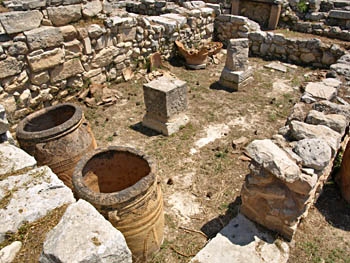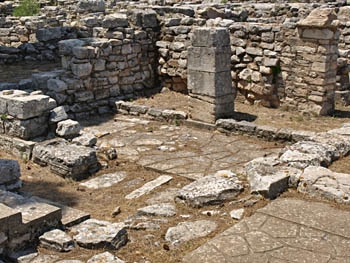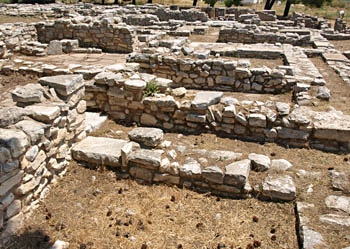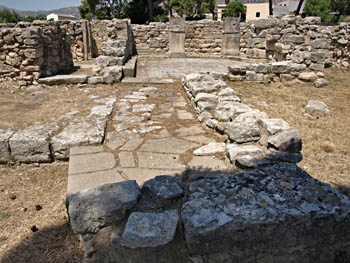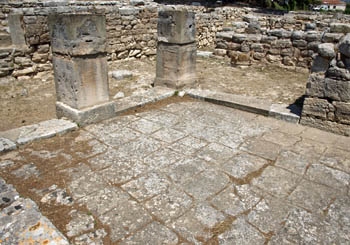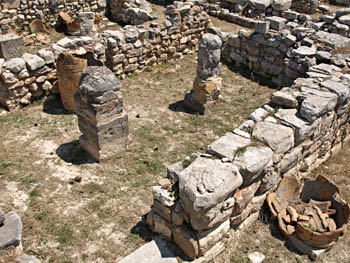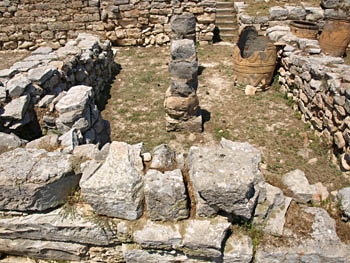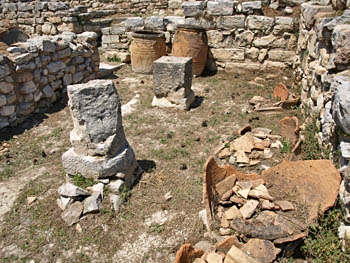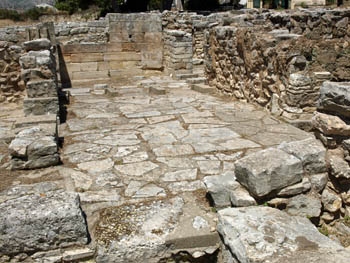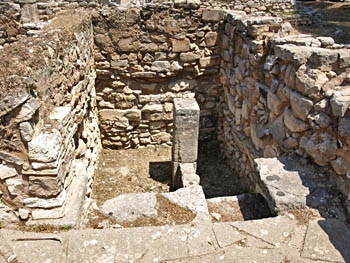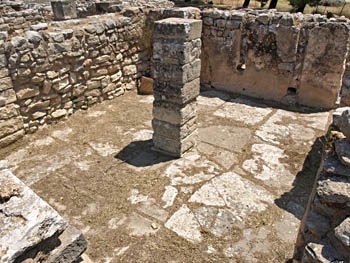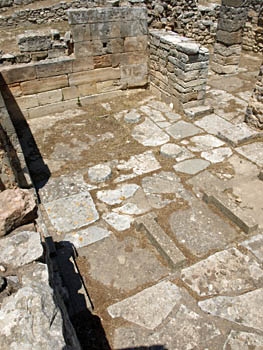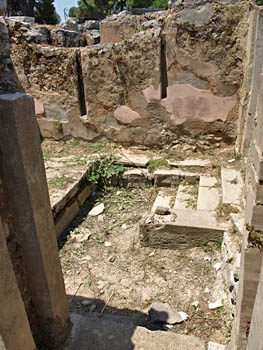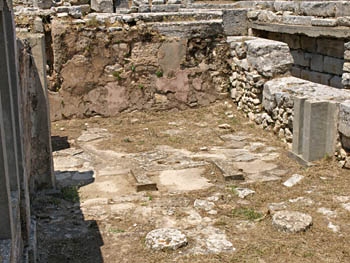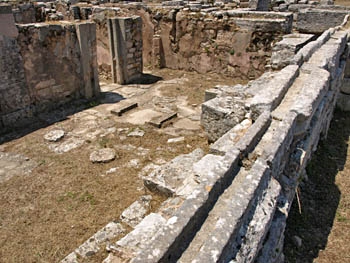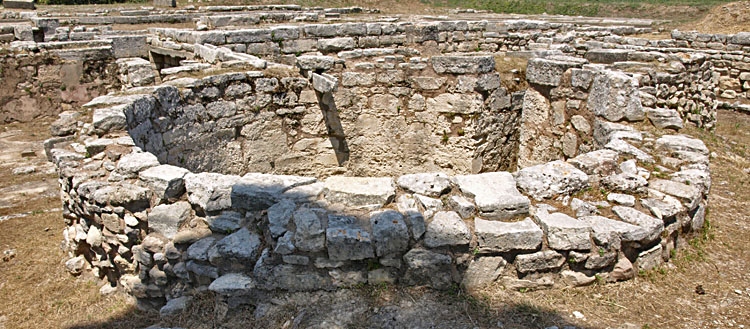The settlement is located in the north corner of the village of Tylisos (also Tylissos), south-west of Heraklion on the road to Anoyeia and Mount Psiloritis. Although the site of the Minoan town was known early in the 19th Century, it was finally excavated by Hadzidakis from 1909-1913. Further excavations were carried out by N. Platon in 1953-55 and by A. Kanta in 1971.
The Minoan town occupied a large area and there are traces of houses from earlier periods (EM II to MM II) scattered throughout the site. Hadzidakis excavated only three of the main buildings and the two most important of these, Houses A and C, date from the very end of MM III (around 1600 BCE in the neopalatial period). They were destroyed by fire in LM IB (around 1450 BCE) when all the major sites in Crete apart from Knossos were either damaged, destroyed or abandoned. The site was later reoccupied early in LM IIIA.
Tylisos was clearly a very important site in Minoan times. Although no palace has been discovered here, much of the architecture was palatial in nature and according to Antonis Vasilakis, more impressive than the architecture of some of the palaces. The miniature frescoes are similar both in style and subject matter to those found at Knossos and may have been produced by the same painters. They make up the second largest group of miniature frescoes in Minoan Crete. The huge size of the three cauldrons found on the site not only attests to the numbers living in the mansions but also to the ability of the inhabitants to obtain large amounts of copper, the supply of which would have been centrally controlled at Knossos. The presence of Linear A inscriptions also points to the importance of Tylisos.
House A is a large mansion which was originally a two storey building. The ground floor alone had 24 rooms. The walls were built of ashlar masonry. The mansion was entered from the east through a pillared court. There are two parts to the building. The northern part was the storage area, and two magazines were located here. A number of large pithoi were discovered here, and over 50 were found throughout the building. The southern part was a residential area, with a number of rooms organised around a Minoan Hall. In one of these rooms a tripod cooking pot was found. In the centre of the living quarters there was a light well.
The Minoan Hall is room 6. Its west wall is the pier-and-door partition outside which is a small, narrow forehall and a light well with columns that form a small portico. Driessen believes the house may have been altered in order to incorporate the Minoan Hall system. Unusually access to twelve of the fourteen rooms in the south wing is gained through the Minoan Hall since by closing the partitions the forehall becomes part of a corridor. This has also been observed at other sites including the palace at Zakros and the Little Palace at Knossos. Room 6 together with the rooms to the east and south of it form a square within a square pattern, which was used in Minoan architecture long before the Neopalatial "villas" were built. Given the number of rooms that lead directly off the Minoan Hall, it would not have been a very peaceful place, certainly during the day, though in the evenings it may have returned to what is considered one of the main roles of the Minoan Hall, as a gathering place.
The rooms to the west of the light well produced the best finds. Room 3, the most northerly of the three rooms contained jars, vases, loomweights and a bronze figurine which had almost certainly fallen from the floor above. Room 4, to the south, contained many small jars and Room 5 originally contained four large bronze cauldrons which were found by a peasant before the excavations began. Two Linear A tablets and some clay sealings were also recovered from the room. The Minoan Hall with its paved floor did not itself yield up anything significant. To the north-east of the Hall there was a lustral basin. A staircase led to the upper floor.
House B has a much simpler design than House A and may have been an annexe although it might actually have predated House A. The building seems to have contained storage rooms, but little was found apart from a large collection of LM I vases in one of the rooms. The building was destroyed by fire.
House C is in fact two buildings. The first was built at the same time as Houses A and B, that is to say in the neopalatial period. After the general destruction of 1450 BCE the remains of the neopalatial mansion were covered with earth and consequently was found to be in quite good condition when it was excavated.
As with House A, the entrance to House C is to be found on the east side of the building. The rooms on the ground floor were connected by a series of four corridors. These linked a possible shrine in the southern part of the building to the store rooms in the western part of the building and finally the residential area in the northern part of the building. There were three staircases leading to the upper floor and in the northern part of the building a lustral basin was found. As well as jars and clay vases, fragments of frescos which had fallen from the upper floor were also discovered in House C.
Later on a LM III building was built on top of House C and even later still a Greek sanctuary covered the northern part of the building. Little remains of the LM III building. A pithos found in the storage area was inscribed in Linear A.
The cistern also dates from the later LM III period. Like the cistern at Zakros it can be entered by steps. An aqueduct with clay pipes can also still be seen. The name Tylisos is to be found in the Linear B tablets from Knossos and is a pre-Greek name. A peak sanctuary which remained in use until at least LM IA is located on the Pyrgos hill above the site.
The site is open to the public and a small admission charge is made.


